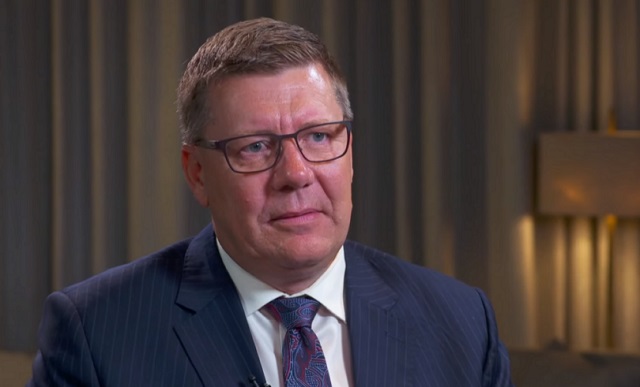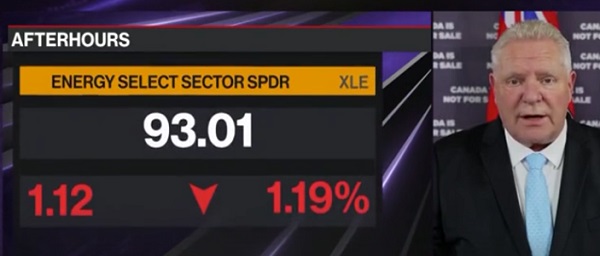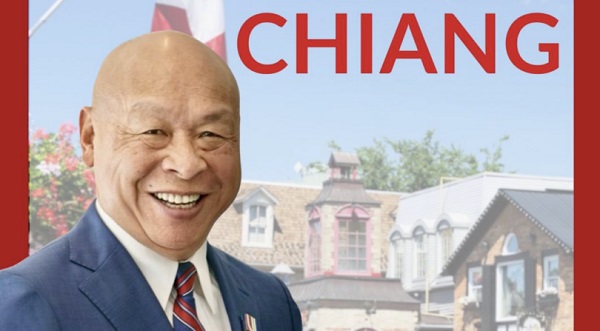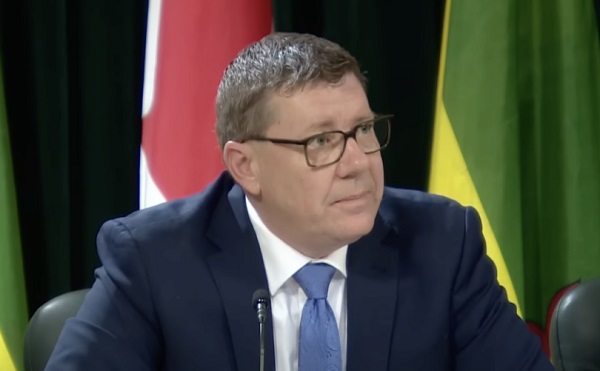National
Saskatchewan files injunction against Trudeau gov’t over carbon tax dispute

From LifeSiteNews
Saskatchewan’s Justice Minister Bronwyn Eyre confirmed Thursday that the province has filed a court injunction to try and stop Canada’s tax agency from seizing its bank account because it has refused to collect an ever-increasing carbon tax instituted by the Liberal government of Prime Minister Justin Trudeau.
In a video update on Thursday posted to X, Eyre, who services as both justice minister and attorney general for Saskatchewan, confirmed that the Trudeau government is “sending the Canada Revenue Agency after the Province’s bank account” over Premier Scott Moe’s refusal to collect the carbon tax on home heating.
Eyre noted that because the “Saskatchewan government was providing the same carbon tax relief here that the federal government was giving to other Canadians,” the Trudeau government is “threatening us again with their favorite move when someone disagrees with them.”
“They’re sending the Canada Revenue Agency after the Province’s bank account. That’s what they’re doing,” she said. “And the reason they’re doing this is because we are providing Saskatchewan residents with the exact same carbon tax exemption as Trudeau is giving other Canadians.”
As reported before by LifeSiteNews, in October of last year, amid dismal polling numbers that showed his government would be defeated in a landslide by the Conservative Party come the next election, Trudeau announced he was pausing the collection of the carbon tax on home heating oil for three years.
While it was a welcomed move by many, home heating oil is almost exclusively used in Atlantic Canada, meaning the tax break really only applied to certain citizens, namely the 24 seats in Atlantic Canada currently held by the Liberals.
Going a step further, Trudeau refused to offer a similar carbon tax relief to those who heat their homes with natural gas, the main product used in provinces such as Alberta and Saskatchewan. This led to Moe announcing his government would take matters into its own hands by pausing the collection of the federal carbon tax on natural gas for home heating, a policy which took effect on January 1, 2024.
Moe has continued to state that his policy is one of fairness, arguing that now citizens of Saskatchewan, like in Atlantic Canada, do not have to pay carbon tax on home heating bills.
In the Thursday video, Eyre said that it is “unconstitutional” to go after a province’s bank account as “section 126 of Canada’s constitution does not allow the federal government to grab money from a province’s bank account.”
“So today, the province of Saskatchewan has filed an injunction to try to stop this unfair and unconstitutional cash grab by the Trudeau government,” she noted.
Eyre added that when it comes to the issue of not collecting the carbon tax, it’s “about fairness and the fair application of the law.”
“The Trudeau-NDP carbon tax should be taken off everything for everyone,” she said. “But until that happens, your Saskatchewan government will protect our province and ensure tax fairness for Saskatchewan families.”
The Trudeau government has not only denied tax exemptions, it has remained adamant that it will continue increasing the carbon tax rate.
On April 1, the Trudeau government increased the carbon tax from $65 to $85 per tonne despite seven of 10 provincial premiers objecting to the increase, and 70 percent of Canadians saying they are against it.
To reach Trudeau’s goal of net zero by 2050, the carbon tax would have to balloon to $350 per tonne.
2025 Federal Election
‘I’m Cautiously Optimistic’: Doug Ford Strongly Recommends Canada ‘Not To Retaliate’ Against Trump’s Tariffs


From the Daily Caller News Foundation
By Jason Cohen
Ontario Premier Doug Ford urged Canadian Prime Minister Mark Carney to avoid retaliation against the tariffs President Donald Trump announced on Wednesday.
Trump announced in the White House Rose Garden that he would impose “a minimum baseline tariff of 10%” on all goods entering the United States, with Canada not being included on the list of countries with higher rates. When asked about what Canada’s response would be on “Bloomberg: Balance of Power,” Ford said he was “cautiously optimistic” about Canada’s omission from the higher-tier tariffs and emphasized the importance of a cooperative relationship with the U.S.
WATCH:
“Well, let’s see where these tariffs go. I’m cautiously optimistic that I never saw Canada or Mexico on that list. And it just goes to show you two great countries working together, collaborating together and building relationships,” Ford said. “So again, I’m cautiously optimistic. I think if that’s the case, it’s the right thing for both the U.S and Canada.”
Host Kailey Leinz noted that there are currently tariffs on Canada in place as well as an exemption for goods that are in compliance with the U.S.-Mexico-Canada Agreement (USMCA).
“Does that mean, sir, at least in your mind, that it wouldn’t be appropriate for Canada to retaliate for this at this time?” Leinz asked.
“That is correct. If that’s the case, then I would highly recommend to the prime minister not to retaliate. And let’s carry on a strong relationship,” Ford answered. “Let’s build the American-Canadian fortress around both countries and be the wealthiest, most prosperous, safest two countries in the world.”
Trump declared a national emergency to levy a slew of reciprocal tariffs on what he has deemed “Liberation Day.”
“My fellow Americans, this is Liberation Day, April 2, 2025, will forever be remembered as the day American industry was reborn, the day America’s destiny was reclaimed, and the day that we began to make America wealthy again,” Trump said.
The president also announced that he would proceed with implementing a 25% tariff on “all foreign-made automobiles” that will take effect at midnight.
Ford in March had imposed a 25% surcharge on electricity to New York, Michigan and Minnesota, but promptly rescinded the policy and apologized to Americans on WABC’s “Cats & Cosby” radio show the following day. The tariffs were a retaliatory measure against Trump’s flurry of tariffs against Canada since starting his second term.
2025 Federal Election
Liberal MP resigns after promoting Chinese government bounty on Conservative rival

From LifeSiteNews
“I find it incredible that Mark Carney would allow someone to run for his party that called for a Canadian citizen to be handed over to a foreign government on a bounty,” he said at a recent rally. “What does that say about whether Mark Carney would protect Canadians?”
Liberal MP candidate Paul Chiang has dropped out of the running after being exposed for suggesting Canadians turn in a Conservative Party candidate to the Chinese consulate to collect a bounty placed on the man by the communist regime.
In an March 31 statement, Chiang, the Liberal candidate for the Markham-Unionville riding, announced his departure from the race after a video of him suggesting a bounty could be claimed for Conservative candidate Joe Tay by handing him over to Chinese authorities circulated on social media. The Royal Canadian Mounted Police have announced they are “probing” the comments.
“I am proud of what we have achieved together and I remain deeply grateful for the trust placed in me,” he said. “This is a uniquely important election with so much at stake for Canadians. As the Prime Minister and Team Canada work to stand up to President Trump and protect our economy, I do not want any distractions in this critical moment.”
“That’s why I’m standing aside as our 2025 candidate in our community of Markham-Unionville,” he announced.
Chiang’s resignation follows backlash from Conservatives and Canadians alike when a January video from a news conference with Chinese-language media in Toronto resurfaced.
In the video, Chiang jokingly suggested that Tay, his then-Conservative rival for the Markham–Unionville riding, could be turned over to the Chinese Consulate General in Toronto in return for $1-million Hong Kong dollar bounty, about $183,000 CAD.
Conservative Party leader Pierre Poilievre was quick to call out Chiang’s suggestion and blasted Prime Minister Mark Carney for keeping him on the ballot.
“I find it incredible that Mark Carney would allow someone to run for his party that called for a Canadian citizen to be handed over to a foreign government on a bounty,” he said at a recent rally. “What does that say about whether Mark Carney would protect Canadians?”
Chiang has since apologized for his suggestion on both social media and personally to Tay.
“Today, I spoke with Joseph Tay, the Conservative candidate for Don Valley North, to personally apologize for the comments that I made this past January,” he wrote in a March 30 X post.
“It was a terrible lapse of judgement. I recognize the severity of the statement and I am deeply disappointed in myself,” he continued.
Carney has said remarkably little regarding the situation. First, he refused to fire the Liberal candidate, referring to Chiang’s statement as a “terrible lapse of judgment.”
“He’s made his apology. He’s made it to the public, he’s made it to the individual concerned, he’s made it directly to me, and he’s going to continue with his candidacy,” Carney said. “He has my confidence.”
Then, following the announcement of Chaing’s resignation, Carney told reporters that it was time to “move on” and that he would “leave it at that.”
-

 2025 Federal Election1 day ago
2025 Federal Election1 day agoMark Carney refuses to clarify 2022 remarks accusing the Freedom Convoy of ‘sedition’
-

 Business1 day ago
Business1 day agoSaskatchewan becomes first Canadian province to fully eliminate carbon tax
-

 2025 Federal Election2 days ago
2025 Federal Election2 days agoLiberal MP Paul Chiang Resigns Without Naming the Real Threat—The CCP
-

 2025 Federal Election2 days ago
2025 Federal Election2 days agoPM Carney’s Candidate Paul Chiang Steps Down After RCMP Confirms Probe Into “Bounty” Comments
-

 Automotive1 day ago
Automotive1 day agoElectric cars just another poor climate policy
-

 Alberta1 day ago
Alberta1 day agoOwner sells gas for 80 cents per litre to show Albertans how low prices ‘could’ be
-

 Break The Needle16 hours ago
Break The Needle16 hours agoWhy psychedelic therapy is stuck in the waiting room
-

 International1 day ago
International1 day agoTrump’s ‘Golden Dome’ defense shield must be built now, Lt. Gen. warns




